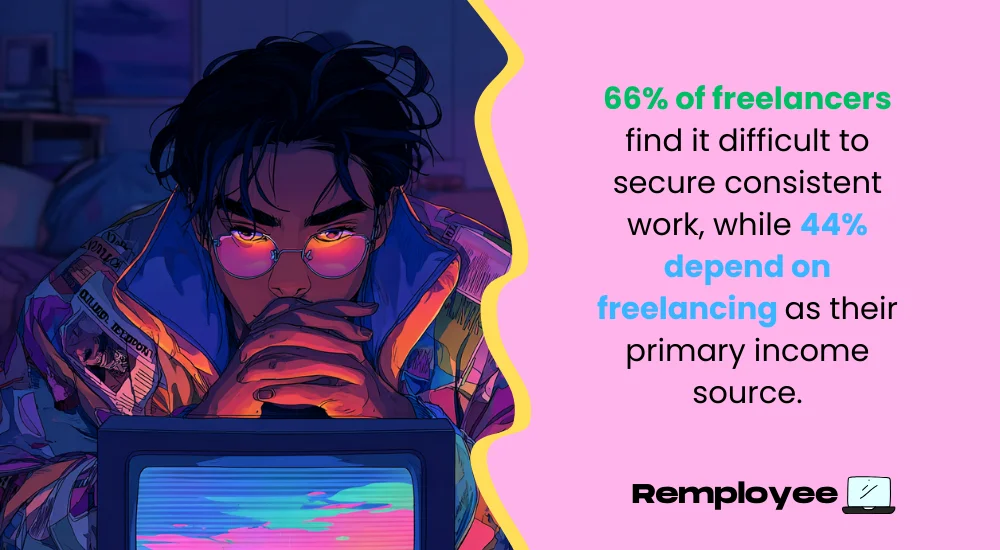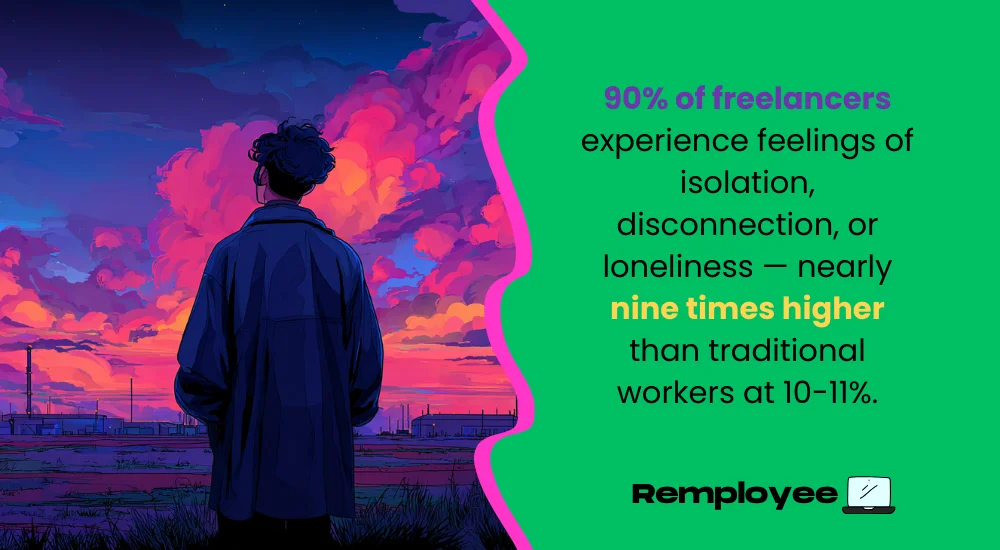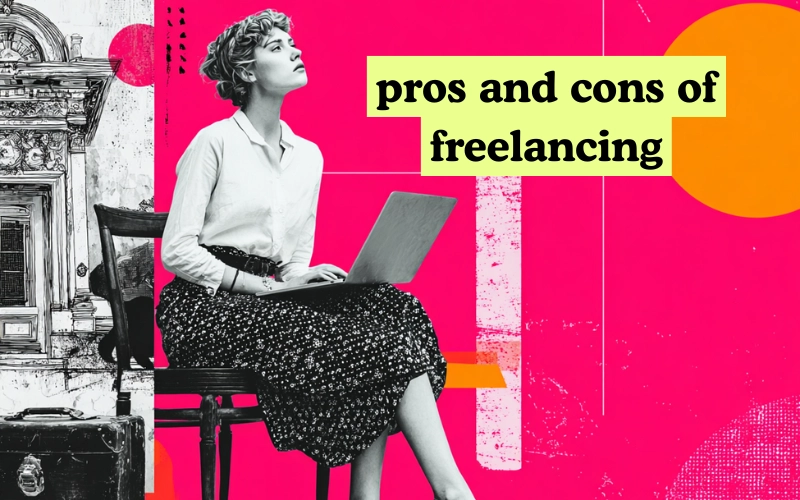Ask a room full of corporate employees about freelancing, and you’ll hear the same wistful refrain: “I wish I could be my own boss.”
But, most people who romanticize freelancing have never invoiced a client at 2 AM or wondered if next month’s rent depends on a project that might fall through. They see the Instagram posts of laptops on beaches, not the spreadsheets tracking unpaid invoices.
Freelancing in 2025 isn’t what it was five years ago. The gig economy has matured, remote work has gone mainstream, and the traditional employment contract is looking increasingly antiquated. But that doesn’t mean freelancing is the promised land.
The truth is more nuanced — and infinitely more interesting. Becoming a freelancer offers a genuine freedom paired with genuine risk. It delivers creative control alongside crushing responsibility. It’s simultaneously the best and worst career decision you’ll ever make.
Let’s dig into what really matters.
Why Freelancing Appeals to the Modern Workforce?

The traditional employment contract broke somewhere around 2015, and nobody bothered to fix it. Companies stopped offering pensions while demanding startup-level commitment. They automated away middle management while expecting everyone to be their own project manager. Meanwhile, technology made it possible to deliver Fortune 500-level work from a kitchen table in your home.
This shift created an opening for freelancing to stop being the backup plan and start being the primary strategy. When your employer treats you like a contractor anyway, why not claim the tax benefits? When every job posting demands entrepreneurial thinking, why not keep the equity?
The appeal runs deeper than laptop photos from Bali beaches. Freelancing offers something traditional employment increasingly cannot: alignment between effort and reward, between value created and compensation received.
1.Freedom and Flexibility: Crafting Your Own Schedule
Every freelancer discovers the same truth within their first month: time becomes negotiable. Not theoretical flexibility where you technically could leave early but never do. Actual, structural flexibility where Tuesday mornings become gym sessions because that’s when your brain refuses to write code.
This autonomy extends beyond daily schedules. Want to spend three months in Portugal while maintaining your client base? Book the flight. Need to care for aging parents without sacrificing your career? Adjust your availability. The constraint shifts from hours logged to outcomes delivered.
You stop asking permission for doctor’s appointments. You stop justifying long lunches when inspiration strikes at 2 PM. But this freedom demands something most employees never develop: ruthless self-management. Without external structure, you become both architect and enforcer of your own productivity systems.
2. The Challenge of Financial Uncertainty

Money arrives differently when you’re freelancing. Sometimes it floods in, three invoices clearing on the same day, your bank account suddenly flush. Other times, it trickles, clients delaying payment while you refresh your banking app like a slot machine.
This volatility rewires your relationship with money. You learn to read cash flow statements the way sailors read weather patterns. Three months of expenses becomes your new zero. You develop contingency plans for your contingency plans. The feast-or-famine cycle teaches harsh lessons about client concentration risk and the importance of recurring revenue.
Even successful freelancers carry anxiety from their early days, when a single ghosted invoice meant choosing between rent and groceries. The psychological toll often outlasts the financial one. Security becomes something you manufacture yourself through diversification, systems, and discipline rather than something an employer provides.
3. Creative Control and Choosing Your Clients
Client selection becomes your most powerful tool once you understand its leverage. Unlike employees who inherit whatever accounts land on their desk, freelancers can systematically fire problem clients and court ideal ones. This isn’t fantasy; it’s strategy.
The power to say no transforms everything. That client who sends seventeen revision rounds? Declined. The project that requires expertise you’re not interested in developing? Passed along to someone else.
Instead, you pursue work that builds your portfolio in specific directions. You develop specializations that command premium rates. Your client roster becomes a deliberately curated collection rather than an accident of geography or timing.
However, this freedom comes with responsibility. Saying no requires financial cushion. Being selective demands excellence. The ability to choose only works when clients also choose you back.
4. The Hidden Burden of Self-Management
Running a freelance business means wearing fifteen hats badly before learning to wear five well. You become your own accounting department at tax time, your own IT support when software crashes, your own HR when motivation vanishes.
The administrative burden shocks most new freelancers. Invoicing takes hours. Contract negotiations feel like doctoral defenses. Insurance decisions require expertise you don’t have. Every non-billable task represents money not earned, yet skipping these tasks invites catastrophe. Successful freelancers either develop these skills or budget for outsourcing them. Neither option comes cheap.
Additionally, self-management extends beyond logistics. You must diagnose your own performance issues, design your own training programs, and provide your own accountability. There’s no manager to blame when projects derail. No team to cover when you’re struggling.
5. Earning Potential vs. Income Instability

Freelance math works differently than salary math. Your hourly rate might triple your former wage, but billable hours rarely hit forty per week. Administrative tasks, business development, and client communication eat into earning time without generating revenue.
Yet the ceiling disappears entirely. Employees who double their productivity rarely double their salary. Freelancers who double their efficiency can double their rates, double their clients, or work half the time. The correlation between value delivered and income received becomes direct and immediate.
This potential comes wrapped in volatility. A $15,000 month followed by a $2,000 month averages to decent money but plays havoc with mortgage applications. Banks prefer steady mediocrity to erratic excellence.
The solution involves building multiple revenue streams, maintaining pipeline discipline, and accepting that financial planning looks fundamentally different without predictable paychecks.
Use Remployee’s Freelance Rate Caltulator 👈🏽
6. Isolation, Loneliness, and the Need for Connection

Working alone hits different when it’s every day. The silence that felt peaceful on day one becomes oppressive by month three. Slack notifications replace water cooler conversations. Client calls become your primary human interaction.
This isolation manifests physically and professionally. Without colleagues to bounce ideas off, your thinking becomes circular. Without office friendships, your network stagnates. Without shared struggles, your challenges feel uniquely insurmountable. The mental health impact is real and documented.
Freelancers report higher rates of anxiety and depression than traditional employees. Co-working spaces help but can’t fully replicate organic workplace relationships.
Virtual communities provide support but lack the immediacy of in-person connection. Successful freelancers actively engineer social interaction into their lives. They schedule coffee meetings religiously. They join professional communities. They treat networking as preventive medicine rather than emergency treatment.
7. Skill Growth Through Diverse Projects
Project variety accelerates learning in ways that specialized roles cannot match. A freelance designer might tackle branding on Monday, UX on Wednesday, and illustration on Friday. Each project demands different muscles, different thinking, different tools.
This exposure compounds over time. You develop fluency across disciplines that typically remain siloed in traditional organizations. You spot patterns that specialists miss. Your solution set expands beyond single-tool approaches.
Moreover, client diversity provides real-world MBA training. You learn how venture-backed startups think differently than family businesses. You understand why enterprise clients need different processes than solopreneurs.
This knowledge becomes competitive advantage. However, breadth can sacrifice depth. Without deliberate focus, you risk becoming competent at everything but exceptional at nothing. The challenge becomes balancing exploration with expertise, variety with mastery.
8. Lack of Traditional Benefits and Safety Nets
Benefits packages represent invisible salary that becomes visible once it disappears. Health insurance alone can cost $500 monthly. Retirement contributions, paid leave, professional development budgets, all vanish when you freelance.
The math gets brutal quickly. That seemingly generous hourly rate shrinks after accounting for self-employment tax, healthcare premiums, and unpaid vacation. A $100 hourly rate might equal a $60,000 salary after adjusting for benefits and billable hour reality.
Creating your own safety net requires discipline most humans lack. You must save for your own retirement without employer matching. You must fund your own professional development without training budgets.
You must create your own paid leave by saving surplus during busy periods. Some freelancers thrive with this responsibility. Others find the constant financial planning exhausting. The answer depends less on math skills than on risk tolerance and psychological makeup.
Is Freelancing Right for You? Weighing Lifestyle vs. Security
The decision to freelance isn’t actually about freelancing. Rather, it’s about which constraints you’re willing to accept and which freedoms you’re willing to sacrifice for them.
Traditional employment trades autonomy for predictability. You surrender schedule control but gain reliable income. You accept limited project choice but receive comprehensive benefits. You tolerate office politics but enjoy built-in community.
Freelancing inverts these trades. You claim radical autonomy but shoulder total responsibility. You can work from anywhere but must generate your own structure. You escape bureaucracy but lose institutional support.
Neither path is inherently superior.
The right choice depends on your financial situation, family obligations, risk tolerance, and personal values. Some people need external structure to thrive. Others wither without independence.
The key is honest self-assessment about what actually drives you versus what sounds appealing in theory.
Ben doesn’t buy into “the way it’s always been done.” He’s spent his career challenging hiring norms and rethinking how remote work should feel. At Remployee, he helps create honest tools and opportunities for people tired of the gig economy’s empty promises.



